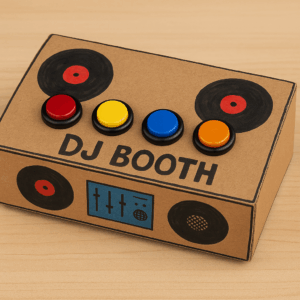Mini DJ Booth: Interactive Sound Console
Concept Overview
The Mini DJ Booth is a physically interactive sound system that combines Arduino and p5.js to simulate the experience of a digital DJ console. The project uses four physical buttons connected to an Arduino board, each mapped to a unique beat and corresponding visual effect displayed through p5.js. When a button is pressed, a signal is sent from the Arduino to the computer via serial communication, triggering both a sound loop and a colorful visual animation on screen.
The physical setup will be built using cardboard, designed to resemble a miniature DJ booth with labeled, color-coded buttons—each representing a different sound or track. The interface invites users to experiment with rhythm and visual design, mimicking the creative flow of live mixing.
Visual Prototype (Generated on ChatGPT)
Interaction Design
- Input: Arduino detects button presses.
- Processing (Thinking): The signal is sent to p5.js, which identifies which button was activated.
- Output: p5.js responds by playing a corresponding beat and generating a synchronized visual (color and shape animation) on screen.
Each of the four buttons triggers:
- A unique sound (e.g., drum, bass).
- A distinct color palette and animation style that matches the mood of the beat.
The more users press the buttons after one another they create different beats and sounds mimicking a real DJ booth.
Materials
- Arduino
- 4 push buttons (I wanna use the bigger ones that we saw during the lab tour as they feel more tactile and look better overall)
- 4 resistors (10kΩ)
- Jumper wires
- Breadboard
- USB cable
- Laptop running p5.js
- Cardboard and paint/decor for the booth design
User Experience
Users interact with the booth by pressing different buttons to layer and remix beats. The immediate audio-visual feedback creates a playful and performative experience, encouraging rhythm exploration and creative expression. The physicality of pressing real buttons, combined with the digital response on screen, merges tactile and visual engagement, much like an actual DJ setup.
Goal
To explore how physical input devices (Arduino buttons) can enhance digital multimedia experiences (p5.js visuals and sounds), creating an accessible, low-cost prototype that bridges sound, motion, and design.
